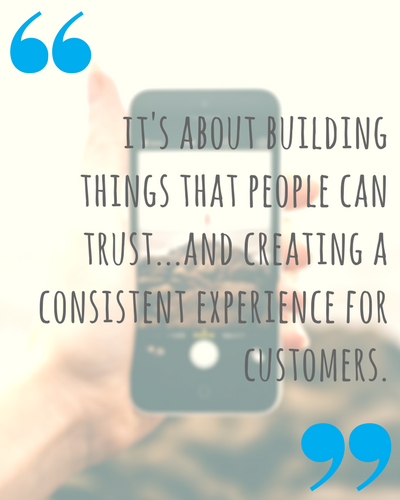
Did you ever stop to think what the ‘link’ is all about?
By Tony Kirsch
Head of Professional Services, Neustar
From as far back as the 1400s, marketing has existed with three simple objectives;
1. to inform consumers about products and services they may want or need;
2. to brand that experience in order to build loyalty or recall; and
3. to prompt customers to take action.
And despite a myriad of technical innovations over that time, the game remains pretty much the same. But things do change.
Innovations evolve from raw, often simplistic initial forms into something far more elegant as utilization spreads and they benefit from continual refinement and learning. This is the core of progress. To question the existing and follow the potential of finding a better way.
This leads me to the URL shortener, or the ‘link.’ A tool built from necessity in a social digital world. A tool that until recently, no-one stopped to ask ‘what the hell are we doing?’
Saving the character count
Writing content for social media has its own particular requirements due to the audience, typical behavior and general restrictions of the various platforms available. Twitter in particular presents a challenge for marketers to adhere to the 140-character limit. However, even this in itself has evolved with Twitter making changes to the treatment of photos, videos and quotes within the character count over the last few years.
But because of these limitations, a new ‘best practice’ has developed – the use of a URL shortener – where the destination URL of the content (typically on a long URL) is transformed into a short URL.

In addition to keeping the number of characters down so you can share more of your genius, one of the additional benefits of using a URL shortener platform is that it can often provide you with great insights into how your posts are being shared, clicked and are otherwise performing.
Options aplenty
Sure, there are lots of options to shorten your URLs – from free services through to more advanced and expensive analytical providers. And if you think about it, you’ve seen them everywhere.
Market leader Bitly (who noticeably rebranded themselves away from bit.ly in recent times) shortens upwards of 400 million links a month which is a staggering number in itself.
Others are infused in your daily social feeds – from bit.ly to goo.gl to ow.ly. And we never blink an eyelid.

The game is changing
The first time I really started to think about this was when Bitly reported that shortened links that have some reference to your brand were capable of driving up to a 34% increase in click-through rate. We’re not talking about minor improvements here – 34% is a massive boost in any context.
And so brands took the advice, to varying levels of success:
- Some did a good job by using a shorter ccTLD or similar – ibm.co etc.
- Some added a little extra to the domain – on.nfl.com
- Some threw a dot in a strange place or abbreviated their brand to make it work – bloom.bg, xfin.tv, ora.cl
- Others just completely hacked something together out of their brand – capitl1.co, at.van.fedex.com, s.gm.com
But despite this clear insight from the organization who really has the data to make such a statement, a large proportion of brands – some of whom really ought to know better – still use generic links in social media.
Time to get real
The .brand juice flowing through my veins was starting to pulse as this all started to formulate in my head. We’ve been teaching all of our customers to use their .brand to get people to the content they want through simple and powerful URLs.
So what really is the difference between a social media link and a link we may use in a TV campaign? Are we constrained by slightly archaic mindsets and could our .brand approach work across traditional and social media platforms?
Looking at the BrandFinance Global 500 brands, 142 of those applied for their own .brand TLD but a staggering half of those .brand owners are using a generic URL shortener or no shortener at all.
Something’s wrong with this picture. Could this be an opportunity to not only see .brand usage increase, but start the process of meaningful link development?

A new way of branding links
For organizations with a .brand, there now exists a better way to approach social links. The ability to create something short, with your recognizable brand to the right of the dot, means the best of both worlds – custom links, control of data and an accurate representation of your brand in every post.
In fact, this can be one of the simplest ways to get started with a .brand domain as we’ve noticed with organizations such as HSBC, Philips and our good selves at Neustar.
But even then, not all customized links are created equal. It’s all well and good to include your brand in your links, but what about that randomly-generated text after the slash?
Think about it, what looks better:
i.neustar/3nsdD7
or i.neustar/socialblog
This part of your link gives people a preview of what to expect. If your brand comes after the dot, the text after the slash gives you the chance to feature a product, service, promotion, content piece and so on, so people know exactly where they’re going when they click.
Which of the options above is likely to get more clicks?
Highly-available tools allow you to easily set up branded link shorteners with the freedom to also customize the extension – and for many of them it’s a free service. It’s almost too simple, and is out there waiting and available for any brand to take advantage of.
The importance of brand in social
The matter at stake here is bigger than freeing up a few more characters in your Twitter posts.
It’s about building things that people can identify and can trust. It’s about increasing visibility of your brand, and your product. It’s about creating a consistent experience for customers.
With a custom link shortener using a .brand, your company’s identity can be present and strengthened with every post, while creating a more trustworthy experience for audiences that they’re more likely to engage with.
On top of this, customizing to the right hand side not only looks better, but gives people something they can identify and connect with.
Identifying, connecting, tracking, building trust, branding. All of these outcomes are crucial to what marketers try to do every single day.
So why are so many stuck in an old way of thinking?
Mark my words, this is a game changer and in the very near future we’re all going to reflect on this and wonder why it took us so long to come up with this simple and efficient improvement to the ever powerful ‘link.’

GoDaddy acquired Neustar's registry business as of August 3, 2020.
Subscribe
Stay up to date with the latest .brand news and views by entering your email below.

